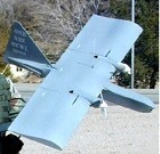
Dragon Eye
Encyclopedia

Unmanned aerial vehicle
An unmanned aerial vehicle , also known as a unmanned aircraft system , remotely piloted aircraft or unmanned aircraft, is a machine which functions either by the remote control of a navigator or pilot or autonomously, that is, as a self-directing entity...
developed by the Naval Research Laboratory and the Marine Corps Warfighting Laboratory for use by the U.S. Marine Corps.
It is a tailless design with a rectangular wing and twin props. It is designed to fit into a backpack, with a weight of 2.25 kilograms (5 pounds) and a span of 1.14 meters (3 feet 9 inches). It can be launched by hand or using a store-bought bungee cord. It also uses a break-apart system to increase durability — parts of the plane break apart instead of shattering and can be reattached later or replaced with new parts. It has a GPS-INS-based waypoint navigation system.
One of the interesting features is that the operator monitors Dragon Eye operation through "video goggles" connected to a laptop computer. The control system weighs about 5.4 kilograms (12 pounds).
The Dragon Eye aircraft is used primarily for scouting urban areas, and is especially useful in urban assaults. Its camera, when used with a trained Marine, can be used to spot enemies without alerting them to the UAV's presence.
The production contract for Dragon Eye was awarded to AeroVironment
AeroVironment
AeroVironment Inc. is a technology company in Monrovia, California, and Simi Valley, California, that is primarily involved in energy systems, electric vehicle systems, and unmanned aerial vehicles . Paul B. MacCready, Jr., a famous designer of human powered aircraft, founded the company in 1971...
in 2003, and over 1000 aircraft were built before the Marines switched over to another UCAV of AeroVironment (RQ-11 Raven B) for the remainder of the Dragon Eye production contract
The Dragon Eye has been used in post-invasion Iraq, 2003–present.
General characteristics
- Length: 0.9 m (3 ft)
- Wingspan: 1.1 m (3.75 ft)
- Ceiling: 90 to 150 m (300–500 ft)
- Weight: 2.7 kg (5.9 lb)
- Cruising speed: 65 km/h (40 mph)
- Battery Endurance: 1 hour
- Range: 5 km (3.1 mi)
- Transmission Range: 10 km (6.2 mi)
- Endurance: 45–60 minutes
External links
- AeroVironment Dragon Eye
- Project description - from U.S. Joint Forces CommandUnited States Joint Forces CommandUnited States Joint Forces Command was a former Unified Combatant Command of the United States Armed Forces. USJFCOM was a functional command that provided specific services to the military. The last commander was Army Gen. Raymond T. Odierno...
. - Dragoneye Update
- Mini and Micro UAVs
- AeroVironment, Inc.

